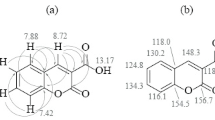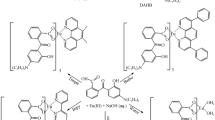Abstract
Seven novel coumarin derivatives derived from salicylaldehyde and phenol were synthesized and characterized by 1H NMR and 13C NMR spectra, mass spectra, infrared spectra and elemental analysis. Their corresponding Eu(III) complexes having general formula EuL1−7(NO3)3⋅2H2O were successfully prepared and characterized by elemental analysis, EDTA titrimetric, molar conductivity, UV–Vis, FT-IR and thermal performance studies. The luminescence properties, fluorescence quantum yields and the electrochemical properties of the title complexes were investigated. The results showed that the title complexes exhibited characteristic emissions of europium ions and possessed relatively good fluorescence quantum yields. The luminescence intensity of the complex with bromine-substituted group is the strongest among all the title complexes. The introduction of electron-withdrawing groups can increase the luminescence properties and fluorescence quantum yields, decrease the HOMO and LUMO energy levels of the title europium complexes, but electron-withdrawing group conversely. And these title complexes may possibly be useful for studying in luminescent materials field.

Synthesis route of the ligands L 1−7







Similar content being viewed by others
References
Zhou J, Lu ZG, Shan GG, Wang SH, Liao Y (2014) Gadolinium complex and phosphorescent probe-modified NaDyF4 nanorods for T1-and T2-weighted MRI/CT/phosphorescence multimodality imaging. Biomaterials 35:368–377
Mishra A, Fouskova P, Angelovski G, Balogh E, Mishra AK, Logothetis NK, Tóth É (2008) Facile synthesis and relaxation properties of novel bispolyazamacrocyclic Gd3+ complexes: an attempt towards calcium-sensitive MRI contrast agents. Inorg Chem 47:1370–1381
Feng J, Zhang HJ (2013) Hybrid materials based on lanthanide organic complexes: a review. Chem Soc Rev 42:387–410
Suzuki H, Hattori Y, Iizuka T, Yuzawa K, Matsumoto N (2003) Organic infrared optical materials and devices based on an organic rare earth complex. Thin Solid Films 438:288–293
Wei HB, Yu G, Zhao ZF, Liu ZW, Bian ZQ, Huang CH (2013) Constructing lanthanide [Nd (III), Er (III) and Yb (III)] complexes using a tridentate N, N, O-ligand for near-infrared organic light-emitting diodes. Dalton Trans 42:8951–8960
Oyamada T, Kawamura Y, Koyama T, Sasabe H, Adachi C (2004) Formation of europium chelate complexes by vacuum co-deposition and their application in organic light-emitting diodes. Adv Mater 16:1082–1086
Wang Y, Ji L, Zhang B, Yin P, Qiu Y, Song D, Zhou J, Li Q (2013) Upconverting rare-earth nanoparticles with a paramagnetic lanthanide complex shell for upconversion fluorescent and magnetic resonance dual-modality imaging. Nanotechnology 24:175101
Yang CL, Xu J, Li JY, Lu MG, Li YB, Wang XL (2014) An efficiently colorimetric and fluorescent probe of fluoride, acetate and phosphate ions based on a novel trinuclear Eu-complex. Sensors Actuators B Chem 196:133–139
Sun LN, Zhang HJ, Meng QG, Liu FY, Fu LS, Peng CY, Yu JB, Zheng GL, Wang SB (2005) Near-infrared luminescent hybrid materials doped with lanthanide (Ln) complexes (Ln = Nd, Yb) and their possible laser application. J Phys Chem B 109:6174–6182
Wang W, Huang Y, Tang N (2007) Synthesis and infrared and fluorescence spectra of rare earth complexes with a novel amide-based ligand. Spectrochim Acta A 66:1058–1062
Yadav P, Satapathi S, Kumari M, Chaturvedi A, Li L, Samuelson LA, Kumar J, Sharma SK (2014) Synthesis of two-photon active cinnamoyl coumarins for high-contrast imaging of cancer cells and their photophysical characterization. J Photochem Photobiol A Chem 280:39–45
Amin KM, Abdel Gawad NM, Abdel Rahman DE, el Ashry MKM (2014) New series of 6-substituted coumarin derivatives as effective factor Xa inhibitors: Synthesis, in vivo antithrombotic evaluation and molecular docking. Bioorg Chem 52:31–43
Mahapatra AK, Hazra G, Roy J, Sahoo P (2011) A simple coumarin-based colorimetric and ratiometric chemosensor for acetate and a selective fluorescence turn-on probe for iodide. J Lumin 131:1255–1259
Nakagawa K, Amita K, Mizuno H, Inoue Y, Hakushi T (1987) Preparation of some lanthanoid picrates and the behavior of their water of hydration. Bull Chem Soc Jpn 60:2037
Li J, Li X, Wang S (2012) Synthesis, photoluminescent behaviors, and theoretical studies of two novel ketocoumarin derivatives. Spectrochim Acta, Part A 88:31–36
Geary WJ (1971) The use of conductivity measurements in organic solvents for the characterisation of coordination compounds. Coord Chem Rev 7:81–122
Feigenbrugel V, Loew C, Calve TL, Mirabel P (2005) Near-UV molar absorptivities of acetone, alachlor, metolachlor, diazinon and dichlorvos in aqueous solution. J Photochem Photobiol A Chem 174:76–81
Gansow OA, Loeffler PA, Davis RE, Lenkinski RE, Wilcott MR (1976) Contact vs. pseudocontact contributions to lanthanide-induced shifts in the nuclear magnetic resonance spectra of isoquinoline and of endo-norbornenol. J Am Chem Soc 14:4250–4258
Taha ZA, Ajlouni AM, Al-Hassan KA, Hijazi AK, Faiq AB (2011) Syntheses, characterization, biological activity and fluorescence properties of bis- (salicylaldehyde)-1, 3-propylenediimine Schiff base ligand and its lanthanide complexes. Spectrochim Acta A 81:317–323
Kai K, Zhang HX, Ma RJ, Chen YN, Chu HB, Zhao YL (2013) Synthesis, characterization and enhanced luminescence of terbium complexes with 2-pyrazinecarboxylic acid and butanedioic acid by inert-fluorescent lanthanide ions. J Rare Earths 31:32–36
Tian L, Ren N, Zhang JJ, Liu HM, Bai JH, Ye HM, Sun SJ (2009) Synthesis, crystal structure, luminescence and thermal decomposition kinetics of Eu (III) complex with 2, 4-dichlorobenzoic acid and 2, 2′-bipyridine. Inorg Chim Acta 362:3388–3394
Guo DC, He W, Liu B, Gou LN, Li RX (2013) Synthesis and luminescence properties of 2-(benzylcarbamoyl) phenyl derivatives and their europium complexes. Luminescence 28:280–286
Kirby AF, Richardson FS (1983) Detailed analysis of the optical absorption and emission spectra of europium (3+) in the trigonal (C3) Eu(DBM)3⋅H2O system. J Phys Chem 87:2544–2556
Li WX, Li YJ, Chai WJ, Ren T, Liu Y, Zhang J, Ao BY (2012) Syntheses and fluorescence properties of two novel lanthanide (III) perchlorate complexes with bis (benzylsulfinyl) methane. J Fluoresc 22:651–658
Guo DC, Wu PL, Tan H, Xia L, Zhou WH (2011) Synthesis and luminescence properties of novel 4-(N-carbazole methyl) benzoyl hydrazone Schiff bases. J Lumin 131:1272–1276
Ding BD, Zhang JM, Zhu WQ et al (2002) Fast and convenient determination of HOMO energy level of organic electroluminescent material using electrochemistry method. Chem Res Appl 14:712–714
Acknowledgments
The authors are grateful for the financial support of the National Natural Science Foundation of China (No.J1103312; No.J1210040; No.21341010), the Innovative Research Team in University (No.IRT1238) and chemical excellent engineer training program of Hunan university. We also thank Dr. William Hickey, the U.S. professor of HRM, for the English editing on this paper.
Author information
Authors and Affiliations
Corresponding author
Rights and permissions
About this article
Cite this article
Yan, D., Li, D., Cheng, G. et al. Synthesis, Characterization and Properties of Novel Coumarin Derivatives and Their Europium Complexes. J Fluoresc 25, 849–859 (2015). https://doi.org/10.1007/s10895-015-1563-8
Received:
Accepted:
Published:
Issue Date:
DOI: https://doi.org/10.1007/s10895-015-1563-8




